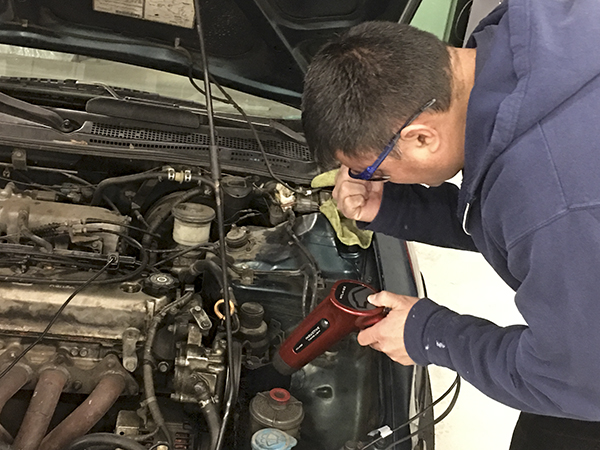Smog Tech: Car-Engine
The car-engine has a crankshaft that rotates at two revolutions per cycle. It also has a camshaft that rotates with the crankshaft, but the camshaft rotates one revolution per cycle.
The most used engine or most commonly used engine is a reciprocating piston.
Smog Tech
Reciprocating car-engine
What is a reciprocating engine?
A reciprocating engine, also often known as a piston engine, is typically an engine that uses one or more reciprocating pistons to convert pressure into a rotating motion.
Smog Tech
car-engine: Four Strokes
The 4-stroke car-engine what is it?
The four strokes, also known as the 4-cycle engine, is when the piston must complete 4 separate strokes while the crankshaft turns.

Smog Tech Class: Student learning how to check timing in the engine performance section of the class
Smog Tech
car-engine: Piston Strokes
What is a piston stroke?
It refers to the full travel of the piston along the cylinder? Let’s review the 4 strokes for the internal combustion engine.
Smog Tech
car-engine: Four Stroke Engine
1.) The intake Stroke: This is the induction stroke. The intake stroke starts when the piston begins at the top dead center (TDC) in the engine block and ends at the bottom dead center.
As the piston moves down to (B.D.C) Bottom Dead Center, it creates a vacuum and pulls in the air/fuel mixture into the cylinder. During this process, the intake valve opens so the air/fuel can pass through into the engine during the intake stroke or the downward movement of the piston.
2.) The Compression Stroke: This stroke starts when the piston is at Bottom Dead Center (B.D.C) or the end of the intake stroke. The compression stroke ends when the piston is (T.D.C) Top Dead Center.
As the piston moves upward, the piston compresses the air/fuel mixture. As the piston compresses the air/fuel mixture just below ignition temperature and below the ignition point. At this point, both the intake and the exhaust valves are closed.
3.) The Power Stroke: This is the second revolution of the four-stroke cycle. The crankshaft has completed a full 360-degree revolution. When the piston is at T.D.C. (the end of the compression stroke), the compressed air/fuel mixture is ignited by ignition spark. Remember, at this point, both the intake and the exhaust valves are closed.
4.) The Exhaust Stroke: During the exhaust stroke, the piston moves from (B.D.C.) Bottom Dead Center to (T.D.C.) Top Dead Center and the exhaust valve beings to open. As the piston moves up the burnt exhaust gases are expelled into the exhaust system
Smog Tech
car-engine: Engine Banks
Remember there are different banks of an engine when you have a V-6 or V-8, bank one is identified by the #1 valve or spark plug location.
Internal combustion piston car-engine (those with more than one cylinder) are usually arranged so that the cylinders are in line parallel to the crankshaft. ... Each line a car-engine has is referred to as a cylinder bank.
Click Here: Smog Inspector Application
CLASS SCHEDULES
Emission Control 1:
B.A.R. Smog Check
Inspector Level 1
(Inspector "Smog" License):
Engine Fundamentals
8am - 12:15 pm
Summer Class
7/5/2022 -8/5/2022
Class # 799065
Emission Control 2:
B.A.R. Smog Check
Inspector Level 2
(Inspector "Smog" License):
Rules and Regulations
8am - 12:15 pm
Summer Classes
7/5/2022 - 8/5/2022
Class # 799067
Engine Performance 1:
8am - 12: 15 pm
Date: TBD
Class # 799069
Engine Performance 2:
B.A.R. Specified Diagnostic
and Repair Training
(Repair "Smog" License)
Time: TBD
Date: TBD
Class # 799071
Emission Control 1
(Inspector "Smog" License):
5:00pm - 8:45 pm
Date: TBD
Class # 799065
Emission Control 2:
(Inspector "Smog" License):
5:00pm - 8:45 pm
Date: TBD
Class # 799065
Exhaust Emissions (Update Class):
5:30 pm - 8:45 pm
Tuesday nights:
Dates: coming soon
Class # 796070